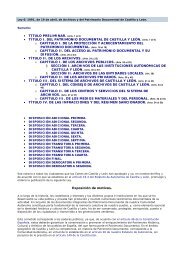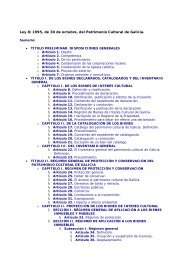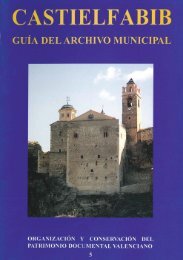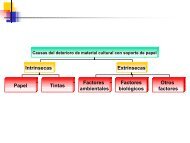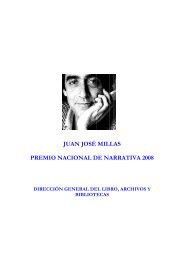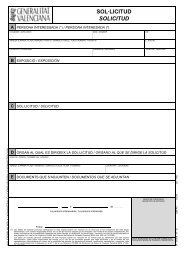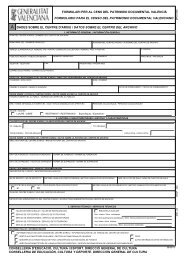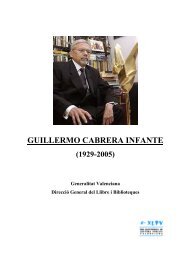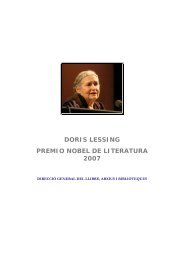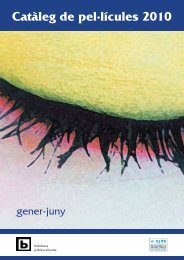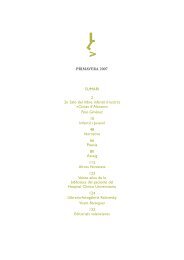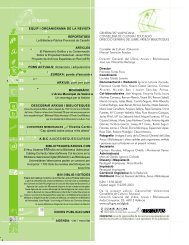Listening to the Past, Speaking to the Future
Listening to the Past, Speaking to the Future
Listening to the Past, Speaking to the Future
- No tags were found...
Create successful ePaper yourself
Turn your PDF publications into a flip-book with our unique Google optimized e-Paper software.
30 The Wider Digital EnvironmentWe must make quite clear why we believe that <strong>the</strong>first priority is access <strong>to</strong> archival records, and not <strong>the</strong>identification of particular archival institutions. Anyoneinvolved in <strong>the</strong> creation of digital resources and servicesor using <strong>the</strong>m will be well aware that searching forinformation and knowledge no longer begins with <strong>the</strong>identification of a particular institution, whe<strong>the</strong>r archive,library or museum. A simple search using an internetcommercial search engine soon demonstrates <strong>the</strong> richdiversity of institutions and individuals offeringinformation, whe<strong>the</strong>r good, bad or indifferent.Given <strong>the</strong> wide distribution of resources that may only berelated by <strong>the</strong> needs of a particular user, an important taskof <strong>the</strong> Archives Gateway will be <strong>to</strong> focus on subject andrelevance. For <strong>the</strong> searcher new <strong>to</strong> a subject, it is only at<strong>the</strong> point where <strong>the</strong> search is refined <strong>to</strong> a small number ofdigital objects, or collection signposts, that <strong>the</strong>y may need<strong>to</strong> be aware of <strong>the</strong> institution that holds <strong>the</strong> archive, objec<strong>to</strong>r collection. For maximum accessibility, this practicalreality must underpin <strong>the</strong> design of Archives Gateway andwill align it within <strong>the</strong> broader development frameworkfor networked information services. It will not, of course,exclude <strong>the</strong> direct, institutional approach of <strong>the</strong>purposive researcher.The ambition is <strong>to</strong> make easily available for <strong>the</strong> first timein one place access <strong>to</strong> collections of documents, movingimages, sound and oral his<strong>to</strong>ry recordings, pho<strong>to</strong>graphs,digital records, objects, books and o<strong>the</strong>r documentsexplaining <strong>the</strong> his<strong>to</strong>ries, cultures and creativity which<strong>to</strong>ge<strong>the</strong>r make up <strong>the</strong> picture of <strong>the</strong> nation, past andpresent. This ambition already underpins <strong>the</strong> developmen<strong>to</strong>f <strong>the</strong> Linking Arms work programme, <strong>the</strong> EnrichUKproject and most recently <strong>the</strong> work of <strong>the</strong> nationalCommon Information Environment Group in which MLAand The National Archives share membership with Higherand Fur<strong>the</strong>r Education, <strong>the</strong> National Health Service, <strong>the</strong>British Library, <strong>the</strong> British Educational Communicationsand Technology Agency (Becta), The Stationery Office,Culture Online and <strong>the</strong> e-Science Core Programme. TheGateway <strong>to</strong> Archives would build on all <strong>the</strong> developmentalwork already done within <strong>the</strong> archives domain and fits in<strong>to</strong>both <strong>the</strong> Common Information Environment Group’sproposed technical specification and its plannedoutcomes.The approach meets all <strong>the</strong> requirements we have definedfor <strong>the</strong> Archives Gateway. It is specifically intended <strong>to</strong>ga<strong>the</strong>r resources from a variety of sources on <strong>the</strong> basis ofwhat is <strong>the</strong> best fit for <strong>the</strong> user. Thus <strong>the</strong> first-time searcherneed not know about archives generally or specifically <strong>to</strong>obtain useful information as part of a search. Mostimportantly <strong>the</strong> system makes it possible <strong>to</strong> widen <strong>the</strong>range of content and ‘sharpen’ searches much more thanconventional search engines are able <strong>to</strong> do. This meansthat it is possible <strong>to</strong> present archival resources <strong>to</strong> a rangeof existing online services and thus add value <strong>to</strong> <strong>the</strong>m atmarginal cost. Examples of this might be <strong>the</strong> increasedavailability of archival information through educationalassets such as Curriculum Online or <strong>to</strong>urism services suchas VisitBritain.com. There would be mutual benefit sincewider audiences would be reached through <strong>the</strong> marketingand development activities of o<strong>the</strong>r service providers whilethose providers would have <strong>the</strong> richness of <strong>the</strong> archivalheritage available <strong>to</strong> <strong>the</strong>m.Given <strong>the</strong> emerging umbrella framework of <strong>the</strong> CommonInformation Environment Group it is possible forinvestment in <strong>the</strong> Archives Gateway <strong>to</strong> be focused in anumber of critical areas that will bring rapid benefits<strong>to</strong> potential users and <strong>to</strong> <strong>the</strong> archive services <strong>the</strong>mselves.These areas are:• Connecting all publicly-funded archives <strong>to</strong> broadbandand providing appropriate hardware and training in useif required (could use <strong>the</strong> MLA People’s Networkdevelopment programme model)• Market studies <strong>to</strong> establish priorities for user demandand identify potential partners• Programmes <strong>to</strong> digitise archival documents focusedon popular <strong>the</strong>mes and <strong>to</strong>pics (could be based on <strong>the</strong>EnrichUK model)• Programmes <strong>to</strong> signpost significant collections throughappropriate description• New services, for example, learning packages for <strong>the</strong>purposive archival resource user, learning resources



